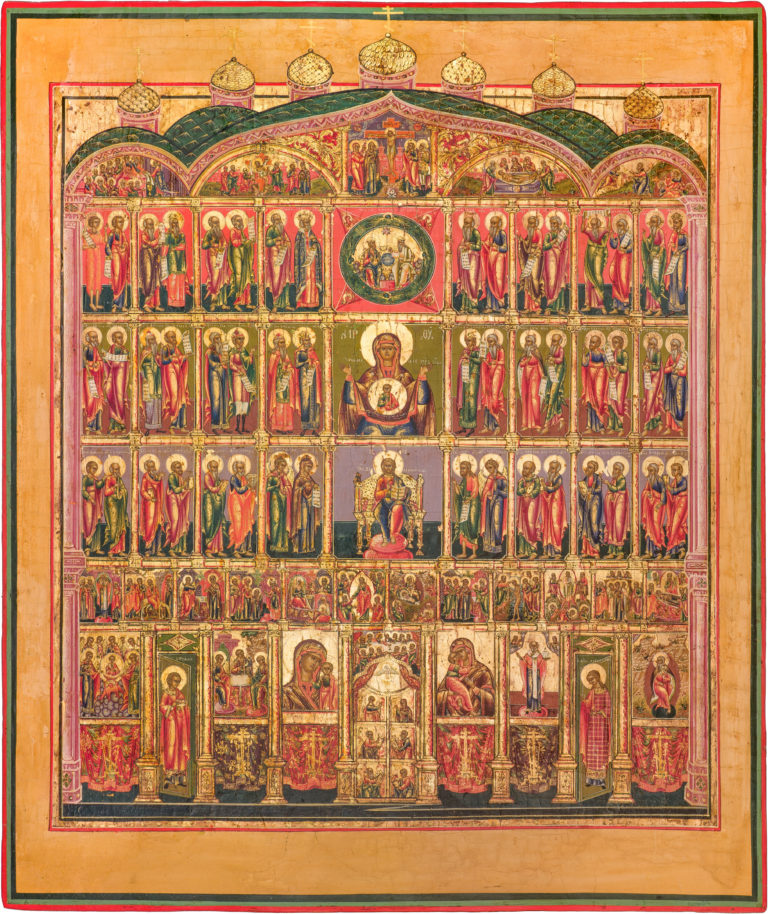The Iconostasis (“The Image of the One, Holy, Catholic, and Apostolic Church”)
Antique Russian icon. Second quarter of the 19th century. Vetka (?).
Size: 54 х 43 х 3 cm
Wood (two panels), two incut support boards (now lost), absence of the incut centerpiece, underlying layer of canvas is not visible, gesso, tempera, gold.
The paintwork is in a generally good condition; chafing is insignificant; slight restoration tonings, primarily on the borders.
Contact us

The Iconostasis (“The Image of the One, Holy, Catholic, and Apostolic Church”)
The given hand-painted icon belongs to a new type of Eastern Orthodox iconography, which strives to imitate the tall, many-tiered Russian iconostasis. Some art historians link the formation of this iconographic type with Russian society’s disenchantment with Western European art appeared after the War of 1812. The general wariness of Western European influence and the intense self-identification and unity of the Russian nation led the artists to search for a new, national style, which actually resulted in the re-discovery of the ancient ecclesiastical tradition. The tall iconostasis was seen as a powerful symbol of Russian Orthodox spiritually, and it naturally was taken up as the main depiction of national religious culture.
These new Eastern Orthodox icons are often called “The Iconostasis” or “The Church.” Most of them actually strive to replicate the iconostasis of the Moscow Kremlin’s Dormition Cathedral. In the 17th century, the cathedral’s iconostasis was restructured by the Patriarch Nikon, who introduced the Apostolic Deesis that can be seen in the given antique icon. The “Iconostasis” was often commissioned by the Popovtsy – one of the two main factions of Old Believers – who retained their clergy and liturgical life, and built churches with altars and iconostases; the three entrances into their Holy of Holies can clearly be seen in this particular antique Russian icon. Not only home prayer, but various Church mysteries (such as marriage ceremonies) were held before such Orthodox icons, which made them increasingly popular. The fact that this religious icon was commissioned by the Popovtsy is also confirmed by the inscription “I.Н.Ц.И.” (“Jesus of Nazareth, King of the Jews”) placed over the cross, as well as the inclusion of the New Testament Trinity (The Enthronement) into the Forefathers’ tier. The latter image, also called “The Triune God,” was venerated only by the Popovtsy, while the Bezpopovtsy – another faction of Old Believers – forbade the uncanonical depictions of God the Father.
The given antique Russian icon represents a miniature depiction of the tall Russian iconostasis that includes six tiers. In the lowest one, we see two religious icon paintings of the Mother of God placed at the sides of the Royal Doors – the Vladimirskaya and the Kazanskaya – while the traditional (and canonical) icon of Christ Pantokrator is completely omitted from the scene. This unusual trait might be explained either by the fact that the artist had to copy a particular iconostasis or by the fact that the Old Believers were completely enamored in Marian veneration, with an excessive number of holy icons of the Mother of God in their homes, chapels, and churches. The second tier contains twelve depictions of the Church Feasts. It is noteworthy that in such religious icons, the Feasts do not follow any chronological order. In the center, along the main axis, we see the icons of the Nativity of Christ and the Resurrection – the Harrowing of Hades, which illustrate the beginning of the Gospel Narrative and the final act of Salvation and victory over Death. The 18-figure Deesis tier includes a “classical” depiction of saints – the Apostles following the figures of Saints Peter and Paul (a tradition introduced by the Russian Patriarch Nikon) – who bow in prayer before the enthroned figure of the Pantokrator (in the majority of other Deesis tiers, Christ Pantokrator is replaced by the icon of “Christ in Majesty”). Over the Deesis lie the Prophetic and the Forefathers’ tiers, and over these – the Passions tier, with the icon of the Crucifixion in the center. The resonating artistry and paintwork, brilliantly executed over the rich gold background, create the impression of an ideal church structure.
The artistic language of the given antique Russian icon is noted for the recognizable color scheme, with its crimson, cherry, dark blue, and emerald green tones. This hand-painted icon is also highly ornamented: the stylized acanthus leaves fill the spaces between the religious icon paintings of the local (or “royal”) tier, while the underlying draperies, bearing the depiction of the Golgotha cross, are completely covered with rich bouquets. The colors and ornamentation of the antique icon, the artist’s clear yearning for the Baroque style, the color scheme, and the execution of the faces – all indicate that this piece was painted in Vetka, one of the major centers of the Popovtsy.